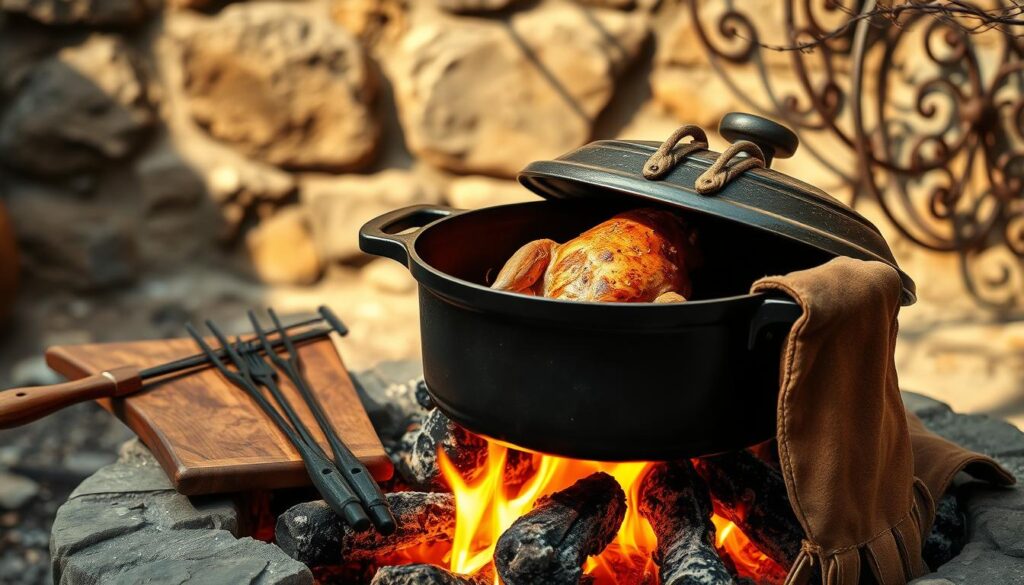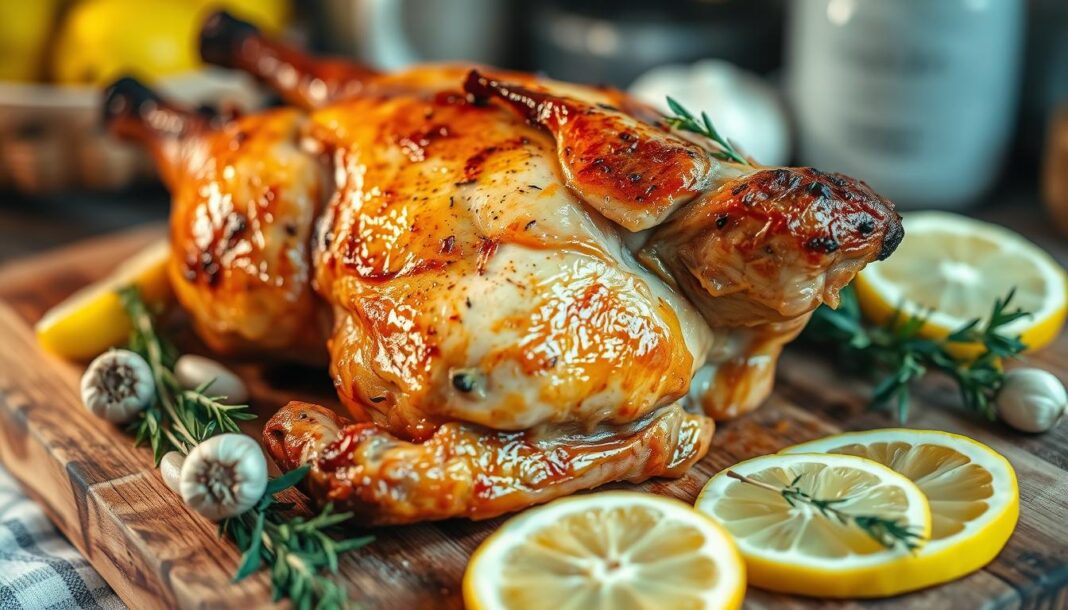Cooking rabbit over an open fire is a culinary tradition that yields exceptionally tender and flavorful meat. At Historical Foods, we have perfected a recipe that brings out the best in this lean game meat. Our comprehensive guide will walk you through each step, from preparation to serving, ensuring a unique dining experience.
Whether you’re a seasoned outdoor cook or trying fire roasting for the first time, our detailed instructions will help you achieve restaurant-quality results. We explain why cooking rabbit over an open fire enhances its natural flavors and creates a truly special meal.
Key Takeaways
- Learn how to select the right rabbit for fire roasting.
- Understand the benefits of cooking rabbit over an open fire.
- Discover expert tips for preparing and cooking rabbit to perfection.
- Explore appropriate accompaniments to serve with your fire-roasted rabbit.
- Gain insights into the culinary science behind fire roasting.
The Art of Fire Roasted Rabbit
The art of cooking rabbit over an open flame is a time-honored tradition that brings out the meat’s natural sweetness. This method of cooking not only enhances the flavor but also provides a unique dining experience.
Why Rabbit Meat Is Worth Trying
Rabbit meat is exceptionally lean and healthy, containing high-quality protein with less fat and cholesterol than many other meats. Its delicate flavor profile, which falls somewhere between chicken and game meat, makes it an excellent introduction to cooking wild game. Rabbit is a sustainable alternative to factory-farmed proteins, offering a culinary experience that’s both environmentally friendly and delicious.
Equipment You’ll Need
To successfully fire roast a rabbit, you’ll need some essential equipment. This includes a proper grill setup, heat-resistant gloves, a meat thermometer, and specialized tools for handling the meat over open flames. 
| Equipment | Purpose |
|---|---|
| Grill Setup | For cooking the rabbit over an open flame |
| Heat-Resistant Gloves | For safe handling of hot grills and meat |
| Meat Thermometer | To ensure the rabbit is cooked to a safe internal temperature |
Preparing Your Rabbit for the Fire
The art of fire roasting rabbit starts with preparation, which involves breaking down the rabbit into optimal pieces. This crucial step ensures that our rabbit cooks evenly and is portioned correctly for serving.
Breaking Down a Whole Rabbit
To break down a whole rabbit, we divide it into six key pieces: the four legs and the two loins with belly meat. While many recipes suggest cutting the rabbit into eight pieces, we find that six is more suitable for this size of rabbit, allowing for better portion control and more even cooking. The process involves identifying the shoulder blade, carefully separating the legs without cutting through the bone, and removing the spine while preserving as much loin meat as possible.
| Rabbit Piece | Description | Cooking Consideration |
|---|---|---|
| Front Legs | Two legs including shoulder | May require slightly longer cooking time |
| Hind Legs | Two legs with more meat | Tender and cooks relatively quickly |
| Loins with Belly Meat | Two loins wrapped with belly meat | Ensures even cooking and retains juiciness |
Creating the Perfect Marinade
Our marinade formula balances acid, fat, and aromatics, featuring olive oil, fresh herbs like rosemary, citrus zest, and aromatic vegetables. To create the marinade, combine minced shallot, olive oil, rosemary, and lemon zest in a bowl. Let it sit for a while to allow the flavors to meld together.
Seasoning Tips for Tender Meat
Season the rabbit pieces liberally on all sides with salt and pepper. Then, spoon the prepared marinade over the meat and gently pat it onto the surface with your fingers. For optimal flavor and tender meat, it’s crucial to season at least 30 minutes before cooking to allow the salt to penetrate properly.
By following these steps and allowing the rabbit to marinate for the right amount of time (1-2 hours), we can achieve tender and flavorful results. Wrapping the belly meat around the loins helps in maintaining juiciness during the roasting process.
Fire Roasting Techniques for Perfect Rabbit
The key to a succulent fire-roasted rabbit lies in understanding the nuances of heat control and meat placement. To achieve this, we’ll guide you through the essential steps of setting up your fire or grill, managing temperature and cooking time, monitoring for doneness, and troubleshooting common issues that may arise during the cooking process.
Setting Up Your Fire or Grill
To start, prepare your grill for roasting with an indirect fire at 500°F. This temperature provides the perfect balance of heat intensity for browning while allowing for controlled cooking. Place the rear legs on the hottest part of the indirect zone, typically toward the rear of the grill and closest to the fire, with the meatiest part toward the heat source.
Temperature and Cooking Time Guidelines
Set a timer for 20 minutes. After 4 minutes, add the two loin pieces to the indirect zone. Close the hood and continue roasting. After an additional 4 minutes, turn all six pieces of meat over. The total cooking time should be approximately 20 minutes. For more detailed roasting techniques, you can refer to our comprehensive guide.
Monitoring for Doneness
Check each piece of rabbit for doneness and for an appealing amount of browning. The rabbit should be cooked to an internal temperature of 160°F. You can verify doneness by checking for clear juices, firm but not hard texture, and slight resistance when pierced.
Troubleshooting Common Issues
Common issues such as flare-ups, uneven cooking, and temperature fluctuations can be managed with proper vent adjustments and by ensuring that the grill is preheated correctly. By maintaining a consistent heat, you can achieve a perfectly cooked rabbit in about 20 minutes to 1 hour of overall time management.
Serving Your Fire Roasted Rabbit
Now that you’ve cooked your rabbit to perfection using the fire roasting method, let’s focus on the art of serving it. The resting period is crucial, allowing the juices to redistribute throughout the meat, making it more tender and flavorful. We recommend a resting time of 10-15 minutes.
For pieces that need a bit more cooking or browning, finishing them on the direct grilling zone can make all the difference. Additionally, glazing with a mixture that includes olive oil can add a rich, complex flavor without overpowering the delicate taste of the rabbit.
When it comes to serving, consider pairing your fire-roasted rabbit with seasonal vegetables, hearty grains, and bright, acidic components. For presentation, you can opt for family-style arrangements or more formal individual servings. Don’t forget to explore creative ways to repurpose any leftover rabbit into delicious next-day meals.
By following these steps, you’ll not only achieve a beautifully cooked rabbit but also elevate your dining experience. Whether you’re cooking for a casual gathering or a formal dinner, your fire-roasted rabbit is sure to impress.


